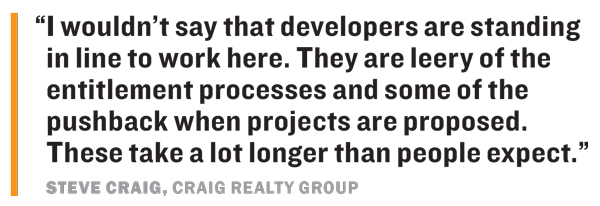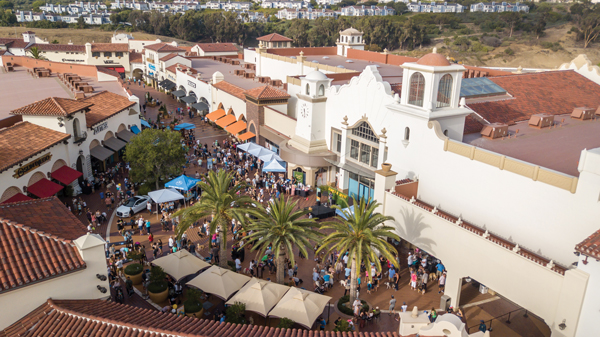Hopes for a full-scale revitalization of San Clemente’s so-called Surfers’ Alley neighborhood may well rest on a former bowling alley.
In early December 2019, the Historic Miramar Theatre property on El Camino Real was sold to Scottsdale, Arizona-based Fortuitous Partners in a deal valued at just under $8 million. The 26,000-square-foot site is home to a theater and bowling alley that have been closed since the early 1990s. The property has been granted entitlements for an upscale food hall and event space, city planners said.
The Miramar project, expected to open within three to five years, could serve as a litmus test for additional potential redevelopment in San Clemente — a city that has long been seen as resistant to such change. The architectural guidelines are strictly enforced, with City Hall mandating adherence to the Spanish Colonial Revival aesthetic. And that’s been one of the reasons that projects in the past have been slow to come to fruition. Those who have guided the city’s growth are looking to other developing areas in Southern California as models for thoughtful growth.
“What happens is that developers come into San Clemente, are not used to our guidelines that are an important part of our tradition, get off on the wrong foot and then they blame the city,” said Wayne Eggleston, former mayor of San Clemente. “In the past, San Clemente has had a reputation as being somewhat difficult. We want the redevelopment, but we don’t want bad redevelopment.”
Jonathan Lightfoot, associate planner for the city of San Clemente, said he envisions a future Surfers’ Alley, formally known as the Los Molinos Business District, that would be similar in aesthetic to Funk Zone in Santa Barbara and Barrio Logan in San Diego.
“Los Molinos is an old industrial area that the city wants to keep,” he said. “We don’t want the entire area to change into being retail or residential. We want to keep the soul of industrial activity and maybe find a middle ground where it becomes more of an interactive space.”
Model cities
A neighborhood that historically housed fishing enterprises, canneries and a naval base, San Diego’s Barrio Logan now hosts art walks and welcomes visitors to new craft breweries. But development is slow and measured, said Mark Steele, chair of the Barrio Logan Planning Committee.
“The community is open to things as long as they stay within the main character of the neighborhood,” said Steele. “We are definitely not trying to stop development.”
Still, Steele said that developers coming into Barrio Logan with plans for boutique hotels have met resistance.

“There have been people looking to repurpose old industrial buildings. If they want to come in and start bulldozing one thing at a time, they’ve lost the point of being here,” he said.
Similarly, the Funk Zone in Santa Barbara has become a popular destination after a years-long redevelopment of a formerly industrial area that is now home to wineries, vintage boutiques and art galleries. The 2017 opening of the Hotel Californian on adjacent State Street cemented the neighborhood’s reputation as the place to be in the city.
“It happened slowly and then all of a sudden,” said Casey Caldwell of the Santa Barbara Arts Collaborative, which promotes the area’s attractions. “The zoning laws in the Funk Zone are not as strict or precise as they are on State Street, where a certain architecture style has to be enforced. So the area is a really interesting blend right now.”
San Clemente’s evolution
The same eclectic, modern vibe of the Funk Zone could certainly come to San Clemente’s Los Molinos Business District and its environs, should all the elements align. The neighborhood earned the Surfers’ Alley nickname due to the abundance of shops dedicated to surf culture, particularly the iconic Rainbow Sandals store, which has been there since 1974.
But developers currently working in San Clemente say that the approvals process remains cumbersome.
“I wouldn’t call it smooth,” said Steve Craig, founder of Newport Beach-based Craig Realty Group, which has projects underway in San Clemente, including an upscale Mexican cantina and a luxury 10-screen movie theater opening later this year.
“I wouldn’t say that developers are standing in line to work here,” he said. “They are leery of the entitlement processes and some of the pushback when projects are proposed. These take a lot longer than people expect.”
As development percolates downtown, home prices in the surrounding area are inching upward. According to figures from First American Title, the average price per square foot of a home in San Clemente jumped 6.2 percent from 2018 to 2019.
And it’s still a bargain, relatively speaking. By the end of 2019, the average residential price per square foot in San Clemente was $497, compared with $622 in nearby Dana Point, according to First American Title Report.
“New homes are always going to sell here,” said Sandy Marquez, who with her husband, Rich, is at RE/MAX Coastal Homes. In 2019, the pair closed 36 deals with a total sales volume of $34 million, Marquez said.
Doug Echelberger, of the Echelberger Group at Pacific Sotheby’s International Realty, said that San Clemente is rife with flippers who are transforming houses from the 1960s and 1970s. The newer the house, the greater the demand.
“There’s a huge difference in value between the houses that have been remodeled or are brand-new and those that date back to before 2010,” said Echelberger. “There can be anywhere between a seven to 14 percent increase in value for the newer homes.”
Houses in Newport Beach or Laguna Beach can be between 30 to 45 percent pricier, and the better values in San Clemente are drawing in buyers from out of state — Arizona, Texas, Kansas, Idaho — who want to be in a beach community, he said. Echelberger said that 80 percent of the buyers he represents are using their San Clemente homes as their primary residences.
“People are moving here from out of the area,” said Marquez. “For the schools, parks, sense of community and open spaces.”
Could the rising interest in local residential real estate translate to more development for the city? Despite the inherent difficulties of developing in San Clemente, insiders like Craig say there’s much about it that will appeal to developers.
“There aren’t too many places in California with access to both the Interstate and Highway 1,” he said. “People have easy access to the ocean, and to ocean views. Why not do something with San Clemente that would be beneficial to people living there?”
